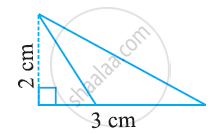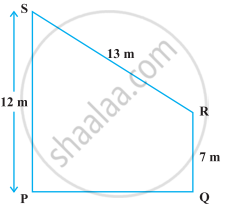Advertisements
Advertisements
प्रश्न
The four vertices of a quadrilateral are (1, 2), (−5, 6), (7, −4) and (k, −2) taken in order. If the area of the quadrilateral is zero, find the value of k.
उत्तर
GIVEN: The four vertices of quadrilateral are (1, 2), (−5, 6), (7, −4) and D (k, −2) taken in order. If the area of the quadrilateral is zero
TO FIND: value of k
PROOF: Let four vertices of quadrilateral are A (1, 2) and B (−5, 6) and C (7, −4) and D (k, −2)
We know area of triangle formed by three points (x1, y1),(x2, y2) and (x3, y3)is given by
`Δ =1/2[x_1(y_2 -y_3)+x_2(y_3-y_1)+x_3(y_1-y_2)`]
Δ`=1/2[x_1y_2+x_2y_3+x_3y_3)]`
NOW AREA OF ΔABC
Taking three point when A(1,2) and B (-5,6) and C (7,-4)
Area (ΔABC)
`=1/2[{6+20+14}-{-10+42-4}`
`=1/2[{40}-{28}]`
`=1/2[{12}]`
Area (ΔABC) =6 sq.units
Also,
Now Area of ΔACD
Taking three points when A (1, 2) and C (7, −4) and D (k, −2)
`=1/2[{-4-14+2k}-{14-4k-2}`
`=1/2[{2k-18}-{12-4k}`
`=1/2[{6k-30}]`
`=[{3k-15}]`
Hence
Area (ABCD) = Area (ΔABC) + Area (ΔACD)
`0=6+3k-15` (substituting the value )
`k=3`
APPEARS IN
संबंधित प्रश्न
If D, E and F are the mid-points of sides BC, CA and AB respectively of a ∆ABC, then using coordinate geometry prove that Area of ∆DEF = `\frac { 1 }{ 4 } "(Area of ∆ABC)"`
Find the area of the quadrilateral ABCD whose vertices are respectively A(1, 1), B(7, –3), C(12, 2) and D(7, 21).
The vertices of a ΔABC are A (4, 6), B (1, 5) and C (7, 2). A line is drawn to intersect sides AB and AC at D and E respectively, such that `(AD)/(AB) = (AE)/(AC) = 1/4`Calculate the area of the ΔADE and compare it with the area of ΔABC. (Recall Converse of basic proportionality theorem and Theorem 6.6 related to ratio of areas of two similar triangles)
Find the area of a triangle with vertices at the point given in the following:
(1, 0), (6, 0), (4, 3)
Find the area of the following triangle:

Find the area of the quadrilaterals, the coordinates of whose vertices are
(−3, 2), (5, 4), (7, −6) and (−5, −4)
If the coordinates of the mid-points of the sides of a triangle are (1, 1), (2, —3) and (3, 4), find the vertices of the triangle.
Show that the points (-3, -3),(3,3) and C (-3 `sqrt(3) , 3 sqrt(3))` are the vertices of an equilateral triangle.
A(6, 1), B(8, 2) and C(9, 4) are three vertices of a parallelogram ABCD. If E is the midpoint of DC, find the area of ∆ADE.
Find the area of the trapezium PQRS with height PQ given in the following figure.

